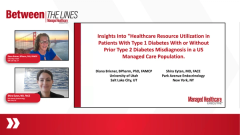
Baseline Differences and Utilization Patterns in T1D Cohorts
Panelists discuss how patients with prior type 2 diabetes misdiagnosis showed significantly higher healthcare utilization rates across all categories (inpatient admissions, emergency visits, outpatient visits, lab procedures, and medications) compared to those correctly diagnosed with type 1 diabetes from the beginning.
Episodes in this series

This segment examines the significant differences in healthcare resource utilization between patients with accurate type 1 diabetes diagnoses versus those who were initially misdiagnosed with type 2 diabetes. The data reveals striking disparities across all healthcare categories. Patients with prior type 2 misdiagnosis showed dramatically higher utilization rates: 11% versus 3% for inpatient admissions, 24% versus 11% for emergency department visits and 99% versus 81% for outpatient visits. Laboratory procedures were also more frequent at 88% versus 53%, and medication prescriptions were higher among the misdiagnosed group, which would be expected since they were inappropriately placed on multiple type 2 diabetes medications.
The clinical implications of these findings are substantial, with prevalence ratios showing robust statistical significance and solid confidence intervals. The increased healthcare utilization among misdiagnosed patients makes clinical sense, as these individuals would experience poor glycemic control, leading to more frequent doctor visits, medication adjustments and, unfortunately, more emergency department visits for complications like hypoglycemia and diabetic ketoacidosis. From both clinical and payer perspectives, this data demonstrates the significant economic impact and patient burden associated with diagnostic delays and inappropriate treatment protocols.
Regarding actionable solutions, guidelines are emerging for appropriate screening protocols, though universal antibody testing isn’t feasible for all patients presenting with elevated glucose levels. Key screening priorities include patients with other autoimmune conditions (particularly Hashimoto’s thyroiditis and celiac disease), family members of type 1 diabetes patients and individuals with apparent type 2 diabetes who remain poorly controlled despite standard oral medications. The clinical recommendation emphasizes thinking beyond traditional stereotypes — not all type 1 patients lack comorbidities like obesity or hypertension, and some may present with overlapping features typically associated with type 2 diabetes. The key is maintaining diagnostic flexibility when standard treatments fail to achieve glycemic control.
Newsletter
Get the latest industry news, event updates, and more from Managed healthcare Executive.




















































